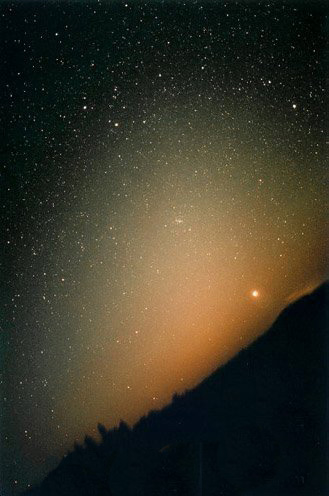Hmm, I'm not sure most folks would understand 'Lambent glow'... Okay, I'll admit it, I had to look it up. Fireflaught, likely not, my readers tend to just read English


The other things are all neat effects but not quite there (speaking of, here's a nice list of optical phenomena:
Optical phenomena - Wikipedia ).
Using 'belt of venus' as an example, that's a wide pinkish band. For me that doesn't work. First off, reds get stripped out of or muted from the spectrum due to the extensive methane in the atmosphere. I'm also envisioning a short (width), narrow (height) band of brightness along the edge of the horizon, and at the center of that extends up that bulging glow, slightly more intense a vertical pillar along the ecliptic, but fans out and fades like the above image.
That said, I did read up on the 'blue hour' due to your link:
Blue hour - Wikipedia . I've long mentioned how after sunset during twilight, I actually see better due to the reduction of glare, yet I also seem sensitive to UV light. That doesn't mean I can see UV, but a lot of objects out in nature become more clear to me and actually stand out (a lot like old blacklight posters tend to do). Then again, my night vision is so good I never use a flashlight... I ramble, huh? hehe.
Thus far we have:
Spill, surge, cascade, flood ('flooded up' was what I was using), ballooned, billowed.
Halo, corona, aureole, glory, shekinah.
Blob...


Lambent, fireflaught (from some strange language), skyglow, bulgy, belt of venus.
From my own flailings: flare, fanned, extended up, flooded up, illuminated (way too vague)
The clumsy (first draft) sentence currently:
Pale hues of the extended false sunset
flooded up from the western horizon and outlined the rim for hours.
or,
The extended false sunset's pale hues
flooded up from the western horizon and outlined the rim for hours.
Hmmm...
K2




